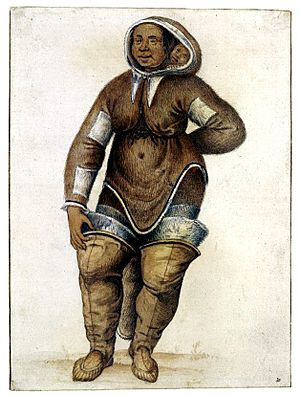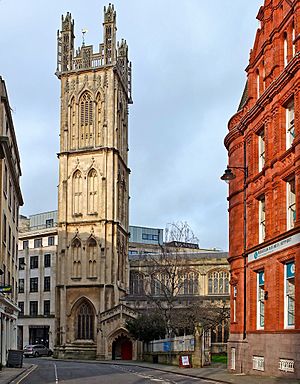Arnaq facts for kids
Quick facts for kids
"Arnaq"
|
|
|---|---|

Arnaq and her baby Nutaaq in a picture by John White
|
|
| Born |
Unknown
North America
|
| Died | 1577 Bristol, England
|
| Cause of death | measles |
| Known for | being the first Inuit who travelled to England |
| Children | Nutaaq |
| Notes | |
|
Egnock
|
|
Arnaq or Egnock (died November 1577) was an Inuit woman from what is now Baffin Island, Nunavut, Canada. The English gave her the name "Arnaq." She was taken to England by Sir Martin Frobisher during his second trip to find the Northwest Passage.
Arnaq, her baby son Nutaaq, and an Inuit man named Kalicho were among the first Indigenous people from North America to visit England. Their journey and time in England are well-known from that period. They arrived in the English city of Bristol in late September 1577. Sadly, all three of them died in November of the same year.
Arnaq's Life and Journey
Arnaq was likely born in the Frobisher Bay area of Nunavut in the 1500s. The name "Arnaq" is very similar to the Inuit word for "woman" (ᐊᕐᓇᖅ arnaq). So, her real name is not known.
How Arnaq Was Taken to England
Arnaq and her one-year-old son, Nutaaq, were among four Inuit people brought to England against their will by Frobisher. In 1577, Frobisher's team was looking for what they thought was gold ore near Kodlunarn Island. They found an empty Inuit camp with European clothes. They believed these clothes belonged to five of Frobisher's men who had disappeared on an earlier trip.
Captain York, part of Frobisher's team, wanted to capture some local Inuit. He hoped to trade them for the missing English men. After a struggle where some Inuit men died, the English captured an old woman (who they later let go) and Arnaq with her baby. Arnaq was then brought to the main expedition and met another captive Inuit, Kalicho.
The English tried to arrange a trade for their missing men, but it did not work out. So, Arnaq, Nutaaq, and Kalicho were taken back to England. They left on August 23 and arrived in the port of Bristol around the end of September.
Life in England
In England, the three Inuit people became very famous. Frobisher planned to introduce them to Queen Elizabeth. He hoped they could learn English and share information about their home country. He also wanted them to be interpreters for future trips.
The family stayed at the mayor's house in Bristol. Kalicho showed off his kayaking and hunting skills in Bristol harbour. An artist named Cornelis Ketel painted four official pictures of Arnaq. Two of these paintings were given to the Queen and hung in Hampton Court Palace. These paintings are now lost. However, paintings by another artist, John White, survived and were copied many times.
Sad Endings
Kalicho died on November 8. He had an infection from broken ribs, likely from when he was captured. After doctors examined him, Arnaq was made to watch his burial at St Stephen's Church in Bristol. A doctor named Edward Dodding wanted Arnaq to see the funeral. He wanted to show her that the English were not cannibals. He even showed her human bones to make his point.
Soon after the funeral, Arnaq became sick. It is believed she caught measles. She died within a few days and was buried on November 12 at St Stephen's Church. In the church records, Kalicho was called Collichang, and Arnaq was called Egnock.
Arnaq's death left Nutaaq without parents. Nutaaq was given a nurse and taken to London. He was supposed to meet Queen Elizabeth. But Nutaaq also died, probably from measles. He was buried without a record at St Olave's Church.
Legacy
Arnaq and her son were not the first people from the Americas to visit Europe. Many Indigenous people had visited France in the 1500s. However, England had not had many visitors from the Americas before Arnaq arrived.
Even though they did not live long, Arnaq, Nutaaq, and Kalicho became well-known. This was mostly because of the pictures drawn of them. The most famous pictures are by John White, who may have been on Frobisher's 1577 trip. Queen Elizabeth also asked for two more pictures. She was sad that she had not seen "Frobisher's Inuit." Studies of these portraits show that Arnaq had facial tattoos. They also show details of the parka she wore.


